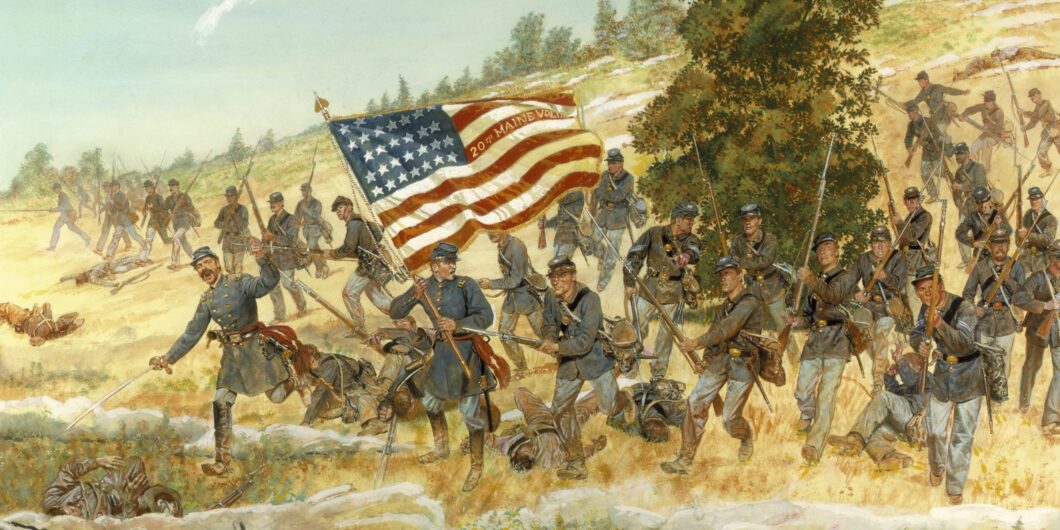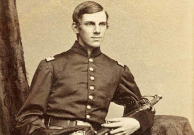A Symphony of These Honored Dead
Though he claims to have compiled the first “oral history” of the Battle of Gettysburg, Bruce Chadwick is among fine company in calling us to hearken to the fallen. Standing among the neat graves at the first Decoration Day ceremony at Arlington National Cemetery, then-Congressman James A. Garfield offered a similar requiem: “And now consider this silent assembly of the dead. What does it represent? Nay, rather, what does it not represent? It is an epitome of the war. Here are sheaves reaped in the harvest of death, from every battlefield of Virginia.”
Garfield told his listeners that the silent dead might be made to speak. Chadwick’s Gettysburg: The Tide Turns offers us the recollections of those who brought on, fought in, and experienced the Civil War’s greatest battle and lived to tell the tale. By necessarily leaning on the accounts of the living, the book is not valuable as military history, as such. It is, however, an achievement in two respects. Chadwick captures well the politics of the Army of the Potomac and the Army of Northern Virginia’s high commands before and during the battle, as well as the relentless gainsaying that occupied the postwar careers of Robert E. Lee and his lieutenants. The finest aspect of the book is that, in weaving together the recollections of 190 generals, soldiers, politicians, historians, and civilians, Chadwick captures the music of the battlefield in a way no other history has.
Chadwick, a journalist whose other books include work on the American Revolution, George Washington, Abraham Lincoln, and baseball, tells the history of the battle reasonably well for a nonspecialist. Lee, miserable in 1863 that a smashing victory at Chancellorsville had achieved no strategic result at the cost of 12,000 casualties, including Stonewall Jackson, made a desperate gamble aimed at capturing a major northern city or cowing the Federals into accepting a concurrent peace offer. Blind because of the unpardonable absence of his cavalry under General J. E. B. Stuart, Lee wandered into a concentrated Union force at Gettysburg led by General George G. Meade, appointed to command the army only three days before. Stiff attacks on July 1 forced the Federals into a pell-mell retreat through the town of Gettysburg but onto high ground in the famous “fishhook” from which they would not be dislodged. All along, Lee’s top lieutenant, General James Longstreet, griped about Lee’s aggressiveness, either predicting defeat or ensuring it with what Lee’s admiring biographer Douglas Southall Freeman called Longstreet’s “sulk[ing].”
Chadwick captures something essential about the Battle of Gettysburg by reanimating its actors’ arguments, exhortations, and recollections. This is his strength; unfortunately, his history fails to match the record on key points. These errors fail to help the reader understand how commands are carried out on the battlefield, where decisions are made not by commanders in their tent but by Billy Yank- and Johnny Reb-on-the-spot.
Take the advent of the battle. In Chadwick’s words, on June 30, Meade “marched his tired men there [to Gettysburg] … believing Lee and his troops were somewhere in the area.” When Union cavalryman General John Buford Jr. encountered Confederate skirmishers northwest of Gettysburg, he was saved by the fortuitous arrival of General John Reynolds (I Corps), determined to defend the town. When Reynolds was promptly killed by a sniper’s bullet, “Lee’s army moved quickly toward the village. So did Meade’s.” And the battle came.
This account misses essential information about Meade’s plans and obscures the responsibility of committing the Army to battle. In fact, rather than determining to hunt the elusive Lee, Meade ordered his Army to take a fortified defensive position in northern Maryland. Nowhere is this mentioned. Nor does Chadwick mention that it was Meade’s subordinate commanders—chiefly Reynolds—who, contrary to Meade’s orders, ordered the Army of the Potomac to Gettysburg.
Chadwick sometimes understands that distance between the headquarters and the battlelines can cause the best-laid plans to go awry. He realizes that Lee, who had also reorganized his army in the wake of Jackson’s death, was ill-suited to his new subordinates. His July 1 order to take Cemetery Hill “if practicable” was less fit for the timorous Richard Ewell than for the spirited but fallen Stonewall. Chadwick argues that, conventionally, it was a “mistake on Lee’s part to send him such a tentative order.” Here, and when his book brings to life the tortuous debates between Longstreet, Lee, and their defenders, Chadwick shows he understands what is lost between the will of the commander and the deeds of his instruments. Because Chadwick understands the problems of command sometimes, his failure to relate key instances of this throughout the Gettysburg campaign suggests the book’s focus is elsewhere: the music and memory of those days.
It is an awesome symphony Chadwick arranges for us, invoking the depths of human passion and reminding us, shamingly, of our generation’s literary poverty.
At one point, Chadwick wonders why the story of Gettysburg has been “told time and time again in books, movies, lectures, and documentaries, but never—and I do not understand why—as an oral history.” The answer is that it is impossible to accurately render a battle’s history merely by its participants’ recollections, sparsely interrupted by the commentary of expert or amateur. This is a fact of war Lincoln knew and transmitted to every schoolchild made to memorize the Gettysburg Address: the “honored dead” cannot speak. Indeed, while General Reynolds brought on the battle when he ordered the corps of Generals Howard and Sickles to Gettysburg, the sharpshooter who felled him from his horse wrote the poor general out of the oral histories. Only the historian proper, not the compiler, can relate the deeds of the dead. Oral history as military history is a fool’s errand, especially on “that field.” The dead are too many.
If he cannot, because of his form or something else, describe events on the battlefield with perfect accuracy, Chadwick nonetheless invites readers into the debates about the battle, the homes of civilians, and the spaces of the battlefield that, even in their carnage, are made intimate by the naked words of those who occupied them. We follow the course of the war as the Army of Northern Virginia gallivants through York, Pennsylvania:
The church bells were ringing and the streets were filled with well-dressed people. The appearance of these men, women, and children in their Sunday attire strangely contrasted with that of my marching soldiers. Begrimed as we were, head to foot, with the impalpable gray powder which rose in dense columns from the macadamized pikes and settled in sheets on men, horses and wagons, it is no wonder that many of Yorks’ residents were terror-stricken as they looked upon us. (General John Gordon)
We hide with Amelia Harmon of Gettysburg and her aunt, who, unlike their neighbors, chose to stay and bear their battle, for their house “was of the old-fashioned fortress type with 18-inch walls and very heavy shutters.” We watch in horror with Nellie Aughinbaugh as she sees “a Union soldier shot down right in front of mother’s home. … [Minutes later] a Confederate came along and he searched the dead man’s clothes. [He] found a small picture of the dead man and apparently his wife and two little children.”
We marvel at two accounts of Pickett’s Charge that Chadwick lays side by side. On Cemetery Ridge, Corporal Thomas Galways observed, “I had often read of battles and of charges, but until this moment I had not gazed upon so grand a sight as was presented by that beautiful mass of gray, as it came on cheering their peculiar cheer, right towards the crest of the hill, which we and our batteries were to defend.” Among that mass, Lieutenant John Dooley (CSA) replies:
I tell you, there is no romance in making one of these charges. When you rise to your feet, I tell you the enthusiasm of ardent breasts in many cases ain’t there. Instead of a burning [desire] to avenge the insults of our country, families, and altars and firesides, the thought is mostly frequently, oh, if I could just come out of this charge safely, how thankful would I be.
And amid the roaring guns and the crying men, Captain Samuel Fiske (USA) hears a lark ascending:
It was touching to see the little birds all out of their wits with fright, flying wildly about midst the tornado of missiles and uttering strange notes of distress. It was touching to see the innocent cows and calves feeding in the fields, torn in pieces by the shell.
It is an awesome symphony Chadwick arranges for us, invoking the depths of human passion and reminding us, shamingly, of our generation’s literary poverty.
Does this symphony have a message? Congressman Garfield, at Arlington Cemetery, thought they might:
If each grave had a voice to tell us what its silent tenant last saw and heard on earth, we might stand, with uncovered heads, and hear the whole story of the war. … We should hear mingled voices from the Rappahannock, the Rapidan, the Chickahominy, and the James; solemn voices from the Wilderness, and triumphant shouts from the Shenandoah, from Petersburg, and the Five Forks, mingled with the wild acclaim of victory and the sweet chorus of returning peace. The voices of these dead will forever fill the land like holy benedictions.
In a way, Garfield made a subtle challenge to the Gettysburg Address. The dead cannot speak, Lincoln told us, and we must speak in their stead. Both Lincoln and Garfield realized the political use of the fallen. Only Garfield taught we can hear the dead, if we can make them speak. Yet Chadwick’s Gettysburg, while helping us to “hear their mingled voices,” does not try to say anything grand about the war. He does not scorn Corporal Napier Bartlett (CSA), who, marching back to Virginia, “shed tears in the way in which our dreams of liberty had ended, and then and there gave them a much more careful burial than most of the dead received.”
Union victory, Chadwick reminds us, was “fought to defend American democracy”: “if government of the people, by the people, and for the people held together, in 1863 or in any year, America would remain a splendid democratic institution.” That feels contemporary. But it is not boastful or vituperative. Overwhelmingly, it is the pity and waste of the “vast slaughter pen” (Henry Matrau, Union Army) that Chadwick conveys and is so characteristic of tragedy. The reader on his own will have to find any meaning in that waste as he tramps with Corporal Bartlett home to Virginia, cheers with Lieutenant Jesse Bowman on Cemetery Hill at the retreating Confederates, or surveys with farmer John Rummel the carnage left behind on his field:
One a Virginian, the other a 3rd Pennsylvania man. They fought on horseback with their sabers until they finally clinched and their horses ran out from under them. Their heads and shoulders were severely cut, and when found, their fingers, although stiffened in death, were so firmly imbedded [sic] in each other’s flesh that they could not be removed without the aid of force.


